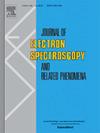Electronic, magnetic and thermal behavior near the Invar compositions of Fe-Ni alloys
IF 1.5
4区 物理与天体物理
Q2 SPECTROSCOPY
Journal of Electron Spectroscopy and Related Phenomena
Pub Date : 2025-04-19
DOI:10.1016/j.elspec.2025.147540
引用次数: 0
Abstract
The structural, magnetic and electronic properties of FeNi ( = 0.32, 0.36, 0.40, 0.50) alloys have been investigated using synchrotron based x-ray diffraction (XRD), superconducting quantum interference device (SQUID) magnetometer and the high resolution x-ray photoelectron spectroscopy (XPS) measurements. The XRD measurement was done down to 50 K temperature. The XRD studies suggest a single phase with fcc structure for = 0.36, 0.40, and 0.50 alloys and a mixed phase for = 0.32 alloy containing both bcc and fcc structures. The lattice parameter of the alloys exhibits a linear dependence on temperature giving rise to a temperature independent coefficient of thermal expansion (CTE). The lowest CTE is observed for = 0.36 Invar alloy as expected while = 0.50 alloy exhibits the highest CTE among the alloys studied. The CTE of the fcc component of mixed phase alloy is close to that of Invar alloy. The temperature dependence of magnetization of the alloys down to 2 K reveals an overall antiferromagnetic interactions within the ferromagnetic phase causing the magnetization decreasing with lowering temperature. The field cooled and zero field cooled data show larger differences for the Invar compositions; this is also manifested in the magnetic hysteresis data at 2 K and 300 K. The Fe 2 and Ni 2 core level spectra exhibit spin–orbit split features along with a satellite feature in the Ni 2 spectra. The spectral line shapes are almost similar for all the compositions studied. Interestingly, the spin–orbit splitting for Fe 3 spectra is larger than that observed for Ni 3 suggesting additional contributions due to the exchange interaction between the Fe 3 core hole with the Fe 3 moment. This suggests large magnetic moment contribution from Fe as expected. The core level and valence band spectra, and the magnetization data suggest significant role of disorder for the Invar compositions.
铁-镍合金因瓦尔成分附近的电子、磁性和热行为
利用同步加速器x射线衍射(XRD)、超导量子干涉仪(SQUID)磁强计和高分辨率x射线光电子能谱(XPS)测量研究了Fe1-xNix(x=0.32,0.36,0.40,0.50)合金的结构、磁性和电子性能。XRD测量在低至50 K的温度下进行。XRD研究表明,对于x=0.36、0.40和0.50的合金,存在具有fcc结构的单相,而对于x=0.32的合金,则存在含有bcc和fcc结构两者的混合相。合金的晶格参数与温度呈线性关系,从而产生与温度无关的热膨胀系数(CTE)。正如预期的那样,x=0.36因瓦合金的CTE最低,而x=0.50合金在所研究的合金中表现出最高的CTE。混合相合金fcc组分的CTE接近殷钢合金。低至2 K的合金磁化强度的温度依赖性揭示了铁磁相中的整体反铁磁相互作用,导致磁化强度随温度降低而降低。场冷和零场冷数据显示殷钢成分差异较大;这也表现在2 K和300 K下的磁滞数据中。Fe 2p和Ni 2p核能级谱在Ni 2p谱中表现出自旋轨道分裂特征和卫星特征。所研究的所有成分的谱线形状几乎相似。有趣的是,Fe 3p光谱的自旋轨道分裂比Ni 3p光谱观察到的更大,这表明由于Fe 3p核心空穴与Fe 3d矩之间的交换相互作用,有额外的贡献。这表明铁的磁矩贡献很大,正如预期的那样。核心能级和价带谱以及磁化数据表明,无序对殷钢成分起着重要作用。
本文章由计算机程序翻译,如有差异,请以英文原文为准。
求助全文
约1分钟内获得全文
求助全文
来源期刊
CiteScore
3.30
自引率
5.30%
发文量
64
审稿时长
60 days
期刊介绍:
The Journal of Electron Spectroscopy and Related Phenomena publishes experimental, theoretical and applied work in the field of electron spectroscopy and electronic structure, involving techniques which use high energy photons (>10 eV) or electrons as probes or detected particles in the investigation.

 求助内容:
求助内容: 应助结果提醒方式:
应助结果提醒方式:


